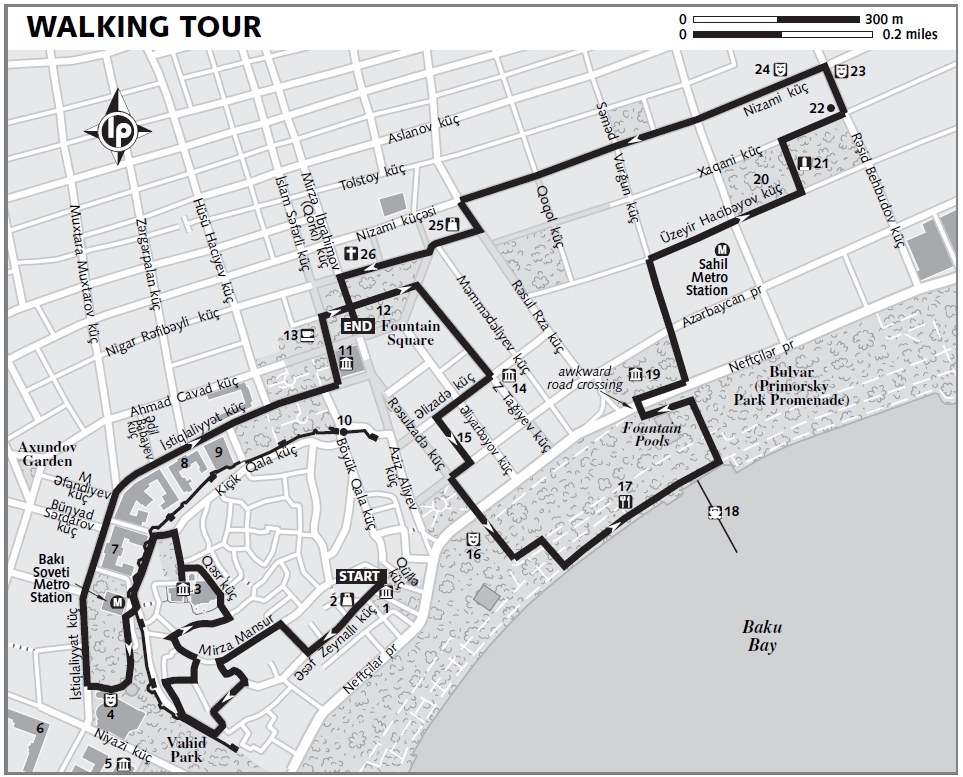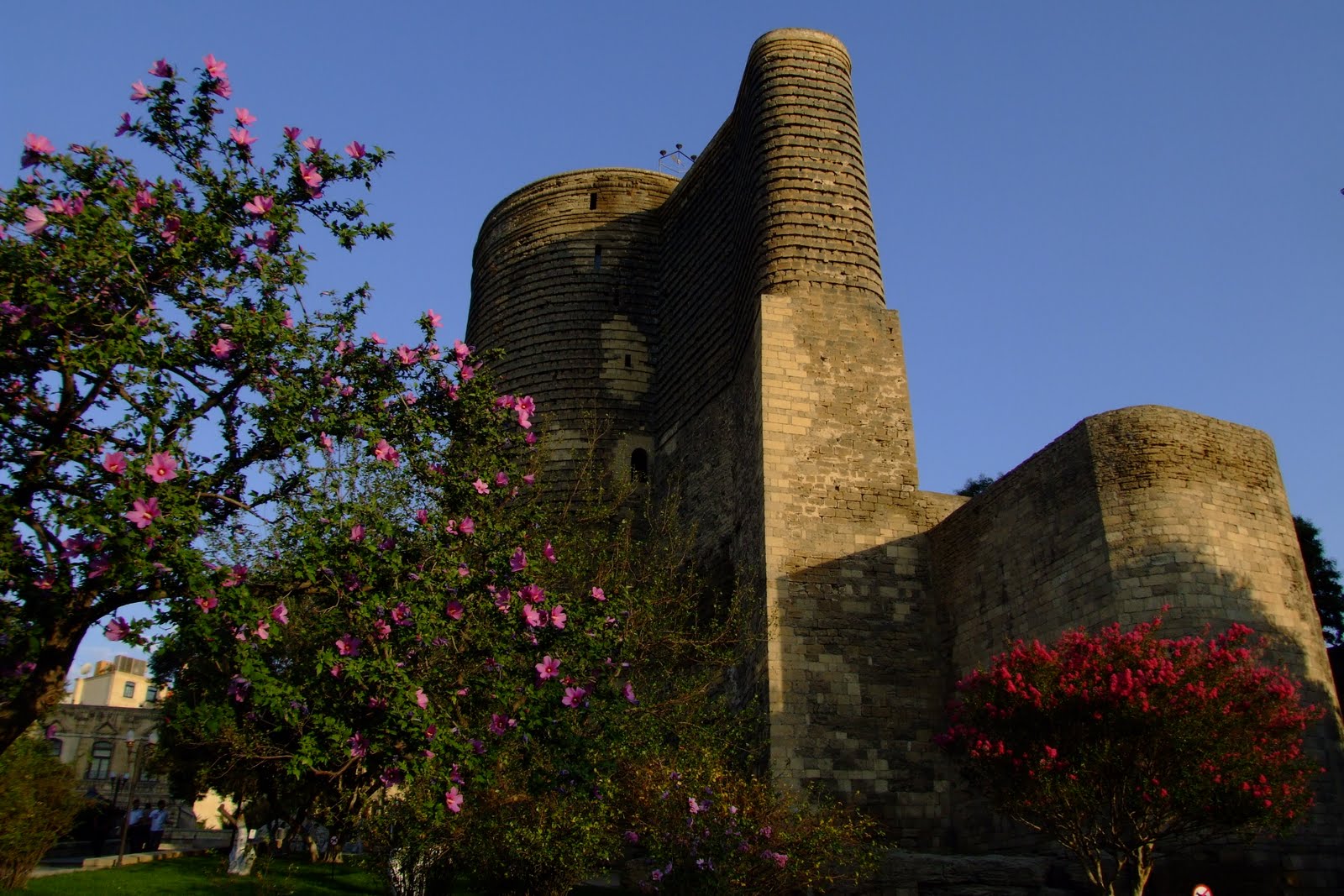
Beyond the Old City gates are dozens more oil-boom houses. To see many of the classic examples follow the walk outlined below. The suggested walking route 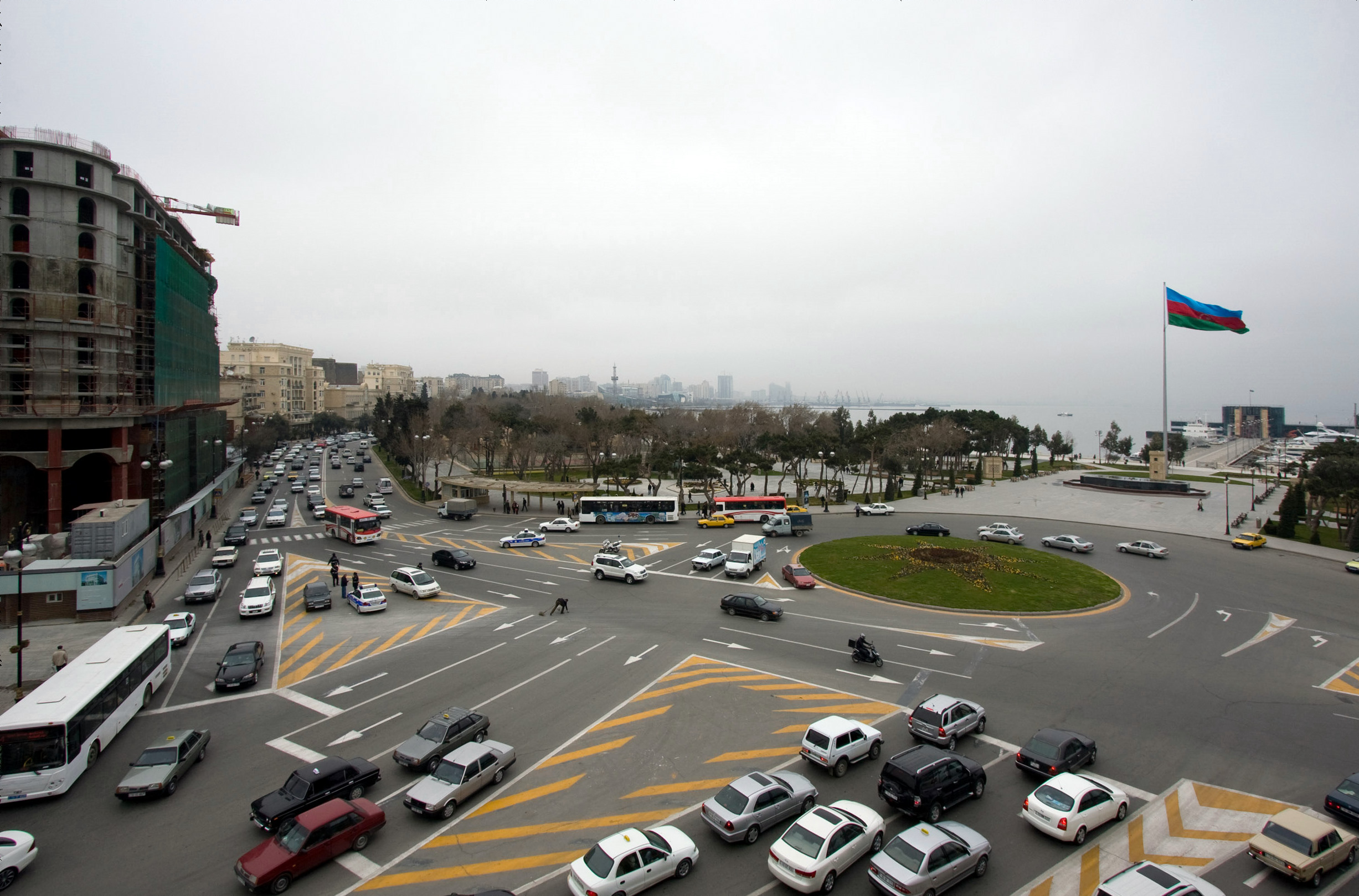 takes a clockwise arc around the northern side of the Old City ramparts starting from Azneft Square (Azneft Meydani), known to most expats as 'SOCAR circle'. That's an acronym for
takes a clockwise arc around the northern side of the Old City ramparts starting from Azneft Square (Azneft Meydani), known to most expats as 'SOCAR circle'. That's an acronym for
the State Oil Co of the Azerbaijan Republic which has its HQ here in a solid 1896 stone mansion. The leaf and lion decorated pile was originally built for a folk singer who turned tycoon. He just happened to hit oil on a piece of land that he had received as a gift for giving a particularly fine performance.
 Azneft is easy to reach, you could walk down/take the funicular from Shahidlar Xiyabani (Martyr's Alley), passing the fountain-statue of heroic Bakhram slaying a giant watersnake.
Azneft is easy to reach, you could walk down/take the funicular from Shahidlar Xiyabani (Martyr's Alley), passing the fountain-statue of heroic Bakhram slaying a giant watersnake.
City Park
Crossing the road is a challenge but City Park is charming especially in the twinkling lights of evening. The park itself, like others in Baku didn't arise spontaneously. Every tree and all the necessary soil was laboriously imported. The park became such a symbol of civic pride that when plans were unveiled to fell 300 of the carefully nurtured trees in 1910 (to build the Philharmonia) there was a storm of protests.

You can continue strolling through the park passing a fountain pool decorated with alien-blue glass hunks and a genteel bandstand-style tea rotunda, to Icheri Sheher metro station. Or, take your life in your hands crossing back across Niyazi St to reach the National Art Gallery (5).
The white tower-block across the road from the Art Gallery guarded threateningly by soldiers is the Presidential Administration (6): photography is strictly forbidden, though were it not nobody would think of snapping a picture anyway.
National Art Gallery
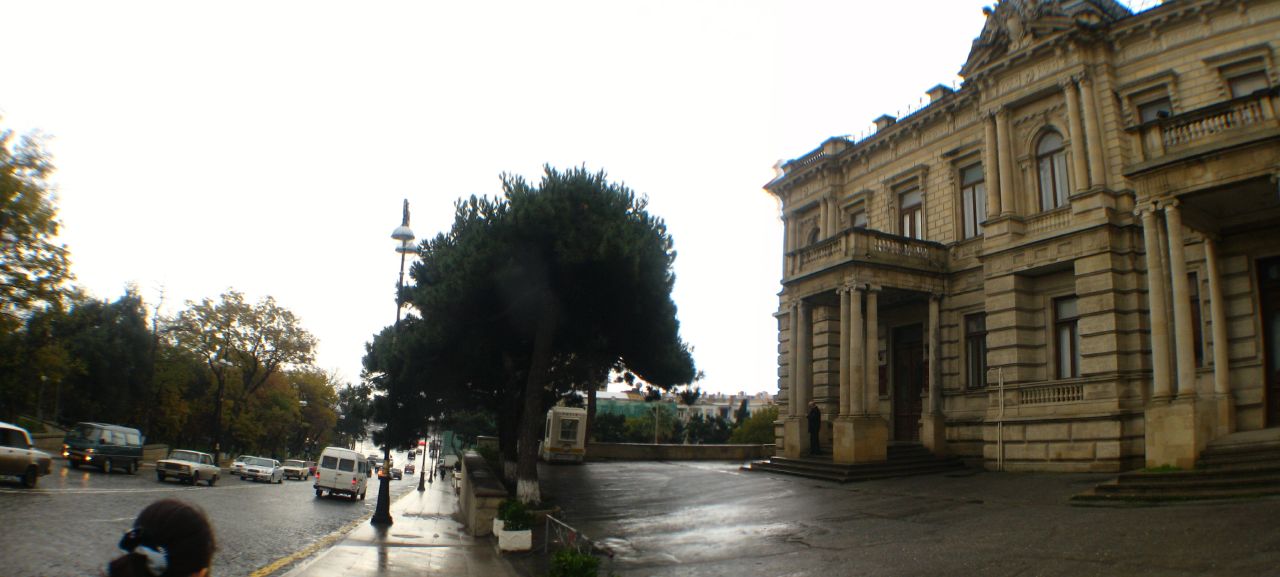 The National Art Gallery (open 10-17:00, last entry 16:00 or earlier) is housed in two fine oil-boom mansions, includes both buildings, of which the second is much the more inspiring. Entry is via the lower building which was built in 1891 for the Dutch representative of Rothschilds. It had a succession of owners, one of whom supposedly bribed the builders of the Philharmonia to construct the open-air stage so that it faced towards his balcony. In the early Soviet era it was, for a while, the official residence of party leaders including Nariman Narimanov.
The National Art Gallery (open 10-17:00, last entry 16:00 or earlier) is housed in two fine oil-boom mansions, includes both buildings, of which the second is much the more inspiring. Entry is via the lower building which was built in 1891 for the Dutch representative of Rothschilds. It had a succession of owners, one of whom supposedly bribed the builders of the Philharmonia to construct the open-air stage so that it faced towards his balcony. In the early Soviet era it was, for a while, the official residence of party leaders including Nariman Narimanov.
Today the big tiled fireplaces and the building itself are more interesting than the minor works of Canaletto and Raphael it contains. There are cabinets of Delft china, a haggard bust of Seneca, and a collection of 19th-century Russian portraits and landscapes. The most interesting Azeri items are Azim Azimzade's cartoons, some miniatures (notably Tabriz-born Mohammad Ali Zavija's work on ivory), the grand brass lamp in the 'carpet room' and the long 18th-century bearded creations reminiscent of Amer-Indian peace pipes.
The upper building was formerly St Mary's School for Girls and now houses an impressive collection of Azeri modern art. In pride of place are many splendid works by Sattar Bahlulzade. Don't miss Zeinalov's entrancing 'Murza', Narimanbekov's 'Mugam' nor the near-kissing pair of wooden sculptures called Friendship (G Abdullayev). The quality is a little diluted by the inevitable inclusion of dull, portrait-carpets of Ataturk, Rasulzade et al but is rescued with Rashid Heidarzade's evocative 'Wrestling Match'.
Istyglalyat Street
When the outer wall of the Old City was torn down in the 19th century, Istyglalyat (Independence) Str had room to develop its fine apartment houses and grand governmental offices amid the meticulously-watered trees. Originally known as Nikolevskaya (after Tsar Nikolai I) and later Kommunistischeskaya only traffic has diminished the charm of this great crescent and almost every building has a tale to tell.
With its splendidly restored pseudo-Safavid mouldings, the mansion neighbouring the corner with Presidential Administration office was built by the merchant Sadykhov brothers and was later the home of prominent 1918 democrat Fatalixan Xoyski. Beyond is the prominent privately-run Western University and second floor Azerbaijan Dunyasi Gallery used for annual exhibitions of children's art No31 Istyglalyat, finished in 1915, was in its day the biggest building in Baku. Hidden away on the uppermost attic-floor is a series of over 20 artists' studios. These are private and totally unadvertised, reached by several long flights of steps from the westernmost entry door, then by a locked spiral metal staircase. You'll need to call ahead for a rendezvous with one of the artists.
Visible across Istyglalyat St is a roughly carved zodiac fountain and Icheri Sheher metro, behind which is the most convenient pedestrian entrance to the Old City for the 15th-century Shirvanshah Palace complex. The sturdy building at [7] is the Baki City Hall (1870 city hall) - note the 'three fireballs' city symbol.
Going further you’ll pass the noble, late-19th-century the Institute of Manuscripts (8) which preserves a fine collection of mainly 18th- and 19thcentury Korans.
Across the road slightly further on the other side of the parallel street is the 'Palace of Happiness', Baku's foremost wedding hall (1911-12), closed Monday and Thursday Other days casual visitors are allowed to peep in at the massive chandelier and art nouveau standard lamps of the hallway and may go further with permission if there's no wedding in progress. The building is one of the most beautiful of all the oil-boom mansions with its fancy spires and its taste in glorious fake-Gothic that echoes many university buildings from Cambridge to Cornell.
From the outside, notice the carved stone knight on the gable high above the doorway. One of sad tales about this building is the tragic circumstances in which the master builder fell to his death while putting the statuette into position The builder's wife, unable to face the sudden transition from fashionable flapper to widow in permanent black chador, killed herself too.
On the wall of 5 Muxtarov St, above the plaque which forever dresses the unfortunate editor Suleiman Malikov in an unfashionable hat and mackintosh, there is a pre-Revolutionary house insurance disk. Hopefully the owner remembered to stipulate that he wanted cover for Fire, Theft and Red Army Invasion. Rounding the corner brings you back to Istyglalyat Str.
Fuzuli Institute of Manuscripts / Former Parliament
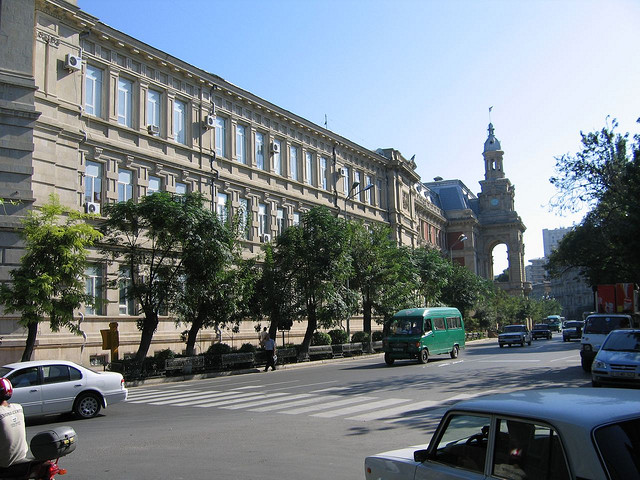 Stick to the northern side of Istyglalyat St. It's best not to gamble your life against the oncoming traffic. Buildings are most attractive viewed from a distance anyway. If you want to take a closer look, it's advisable to return to the underpass at Icheri Sheher metro or continue to the traffic lights at the Husi Haciyev Str junction.
Stick to the northern side of Istyglalyat St. It's best not to gamble your life against the oncoming traffic. Buildings are most attractive viewed from a distance anyway. If you want to take a closer look, it's advisable to return to the underpass at Icheri Sheher metro or continue to the traffic lights at the Husi Haciyev Str junction.
Nowadays Institute of Economics building was a 1904 boys school. Beside the institute is the former Empress Alexandra Girls' School, the first modern girls' school in the Islamic world. It was built by oil-baron Tagiyev on the premise that educating a boy educates one man while educating a girl educates a whole future family. The Mollahs, the powerful Muslim 'clergy', were very much against the idea but fortunately they proved eminently bribeable. The sycophantic name (for the Russian Tsar's wife) helped with the secular authorities.
From 1918 to 1921 the building was used as the national parliament of the Azerbaijan Democratic Republic which moved here from its initial site in Ganja once Turkish troops had scared away the Dunster force. The former parliamentary chamber with its ornate interior, gilded mouldings, Moorish windows and large chandelier has been colourfully renovated and is used to display old miniatures, documents and beautifully illuminated books of the Fuzuli Institute of Manuscripts. The star exhibits include some majestic 18th/ 19th-century Korans, a 1649 copy of Nizami's Xamsa (illustrated in Samarkand) and an especially intricate illuminated divan of the Persian poet Hafez. The octagonal cabinet at the far end contains the personally embroidered album of the Karabagh princess-poet Natavan. The director noted that older, arguably finer examples of many books are held in the British Library/Museum in London. Far from calling for their prompt return, he pointed out the great good fortune that they had been so kept. Most of the original Azeri collection was burnt during one of Stalin's bad moods in the 1930s. The exhibition is open to those with a special interest, phone for an appointment at least one day in advance. Across the hallway is the Hussein Cavid Apartment Museum which is of very limited interest to the casual visitor - his other house museum in Nakhchivan city is more appealing.
Ismailiya Palace
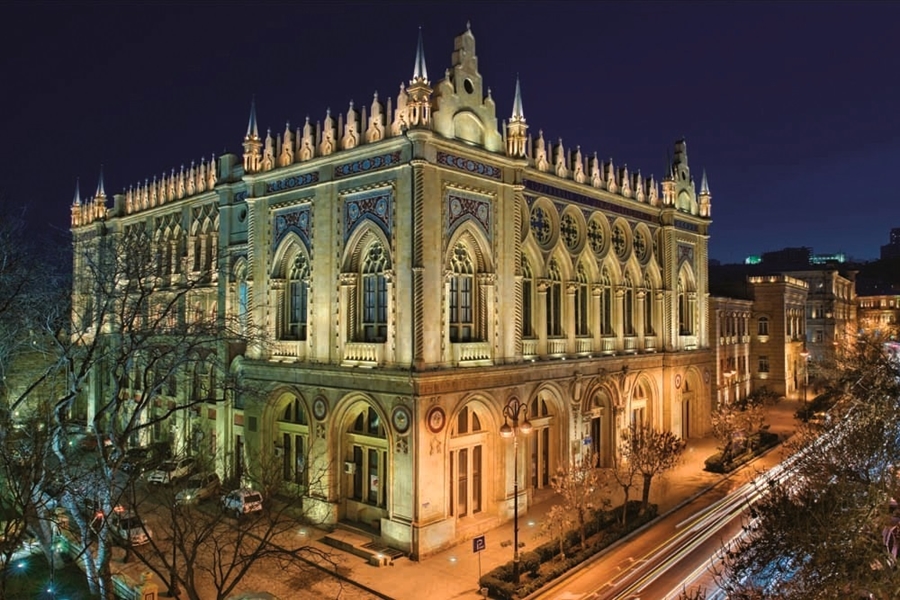 Across the road is a new statue of Yusif Mammadaliyev, and the gorgeous mosaic-fronted Ismailiya Palace (9). The latter was built by the infamously tight-fisted millionaire Nagiyev (not Tagiyev), based on the design of the Palazzo Contarini in Venice. The reason for his lavish expenditure on this building was to memonalize his son, Ismail, who had died of ТВ. Nonetheless, it was so tough for him to spend the money that he asked his accountant to hide the costs from his eyes when he signed the authorization. Initially the building served as the HQ of the Ismaili Co and of the Muslim Philanthropic Organization but it was gutted by arsonists during the inter-ethnic riots of the 1918 'March Days'. The rebuilt version has retained most of the flavour of the original but incorporates Soviet stars instead of Koranic calligraphy as a design motif. Today it is the administrative office of the Academy of Sciences (the Academy itself has its main building in the great Stalinist block at metro Elmar Akadamesi).
Across the road is a new statue of Yusif Mammadaliyev, and the gorgeous mosaic-fronted Ismailiya Palace (9). The latter was built by the infamously tight-fisted millionaire Nagiyev (not Tagiyev), based on the design of the Palazzo Contarini in Venice. The reason for his lavish expenditure on this building was to memonalize his son, Ismail, who had died of ТВ. Nonetheless, it was so tough for him to spend the money that he asked his accountant to hide the costs from his eyes when he signed the authorization. Initially the building served as the HQ of the Ismaili Co and of the Muslim Philanthropic Organization but it was gutted by arsonists during the inter-ethnic riots of the 1918 'March Days'. The rebuilt version has retained most of the flavour of the original but incorporates Soviet stars instead of Koranic calligraphy as a design motif. Today it is the administrative office of the Academy of Sciences (the Academy itself has its main building in the great Stalinist block at metro Elmar Akadamesi).
Towards Fountains Square
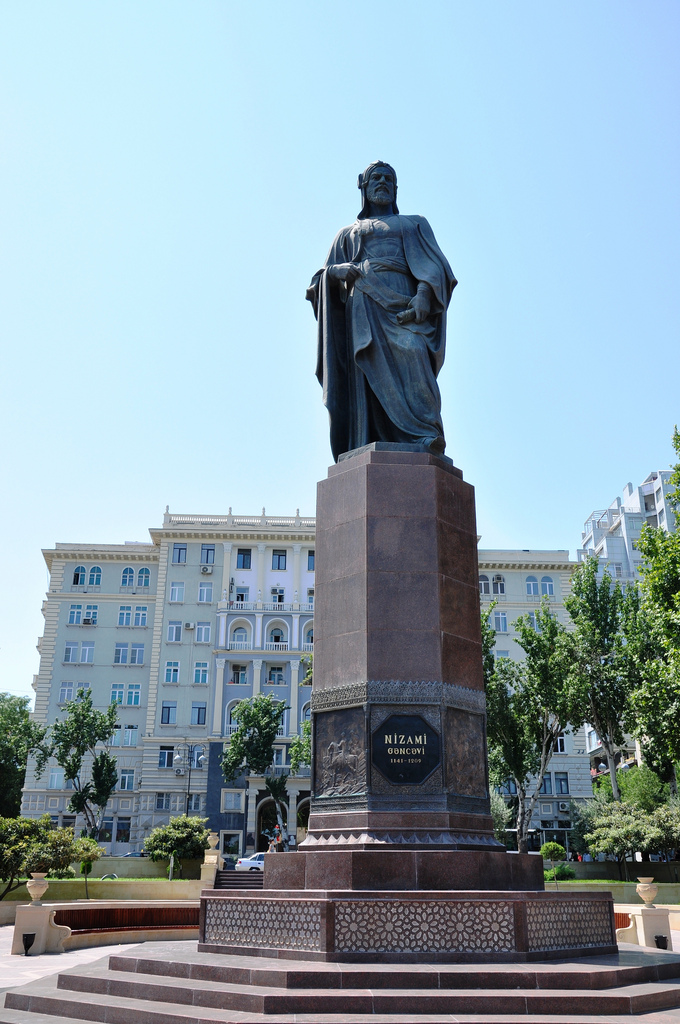 A statue of the Shamakha-born poet Sabir has stood on its present spot since the 1920s. He was posthumously lauded by the Soviet authorities for his stand against the backwardness of Islamic institutions. Quotes like 'I am not afraid of ghosts or devils, but I fear a country where Mollahs rule' - would have had CIA recruiters drooling.
A statue of the Shamakha-born poet Sabir has stood on its present spot since the 1920s. He was posthumously lauded by the Soviet authorities for his stand against the backwardness of Islamic institutions. Quotes like 'I am not afraid of ghosts or devils, but I fear a country where Mollahs rule' - would have had CIA recruiters drooling.
However, his anti-authoritarian views would probably not have gone down too well with Stalin. Sabir's death in 1911 meant that this theory was never tested. But in 1958 when the old statue was replaced by a new Sabir sitting in a chair, the authorities had the last laugh - to have someone 'sit down' is a local euphemism for sending them to jail.
Further down lies the Old City’s sturdy, castlestyle Double Gateway (10), while on your left is the beautiful faсade of the Nizami Literature Museum (11). In front of the Museum there is a proud Nizami statue in the park. A little beyond here, near the Old city's 'double gates' the Russian army's Caucasian commander Tsitsianov came in 1806 to receive the keys to the city from the Baku khan. Instead he received an assassin's bullet from the khan's cousin much to general public delight. The Russian troops fled but returned in force within the year. The area was known as Tsitsanov garden until 1918, its fountain being an important early source of drinking water. As you enter Fountains Square (12), the dramatic facade of the Nizami Museum is ahead of you.
Nizami Literature Museum
 Nizami Museum (11) is second only to Maiden's Tower as Baku's most photographed building. Its facade is especially appealing at night when the statue-filled arches are back-lit. The figures depict great Azeri writers from Fuzuli (15th century) to Jaffar Jabbarli (20th), getting younger north to south. Nizami himself (12th century) stares towards the building from a tall podium in the park opposite. Formerly the Metropole, Baku's top hotel, the building was remodelled into a museum in 1940 preserving only the ground floor. The interior is visually disappointing and tickets relatively expensive for foreigners but the very thorough tour (in English, some extra) is a great introduction to Azeri history and the importance of literary figures in defining a national identity. The exhibits are essentially similar to those in a typical historical museum, though better presented.
Nizami Museum (11) is second only to Maiden's Tower as Baku's most photographed building. Its facade is especially appealing at night when the statue-filled arches are back-lit. The figures depict great Azeri writers from Fuzuli (15th century) to Jaffar Jabbarli (20th), getting younger north to south. Nizami himself (12th century) stares towards the building from a tall podium in the park opposite. Formerly the Metropole, Baku's top hotel, the building was remodelled into a museum in 1940 preserving only the ground floor. The interior is visually disappointing and tickets relatively expensive for foreigners but the very thorough tour (in English, some extra) is a great introduction to Azeri history and the importance of literary figures in defining a national identity. The exhibits are essentially similar to those in a typical historical museum, though better presented.
Fountain Square
 Fountain Square (12) is Baku's pleasantly shady central piazza. It's a great place for people-watching, though the fountains themselves are only switched on during summer evenings.
Fountain Square (12) is Baku's pleasantly shady central piazza. It's a great place for people-watching, though the fountains themselves are only switched on during summer evenings.
Originally the site of a military encampment, the then much smaller square was known a century ago as Parapet and was hemmed in by tram lines. These days it is a spacious, tree-dappled pedestrian area. The fountains have been replaced, the whole square completely modernised and looks very pretty notw.
At the eastern 'nose' of the 'square', 'Art Alley' follows the boutique-filled arches of a former Nagiyev Mansion. It is a great place to rummage through tourist bric-a-brac, old Soviet coins and stamps, not-really-so-rare Russian edition Rolling Stones 33rpms etc. You can get a portrait drawn or silhouette cut while you wait but the paintings on sale are generally rather trashy.
 The surrounding tree-lined streets are full of pubs, restaurants and century-old 'oil-boom' mansions, including one that houses the Historical Museum (14). The city's Historical Museum a must-see if only for the splendid interior of the mansion in which it's housed. Built in 1896, this was the residence of Zeinalabdin Tagiyev, the richest of all the oil barons.
The surrounding tree-lined streets are full of pubs, restaurants and century-old 'oil-boom' mansions, including one that houses the Historical Museum (14). The city's Historical Museum a must-see if only for the splendid interior of the mansion in which it's housed. Built in 1896, this was the residence of Zeinalabdin Tagiyev, the richest of all the oil barons.
Despite deceptively modest facades, the lavish decor of the upper floor reception rooms are unparalleled in Baku. Western guests were formerly entertained in the White (or European) Hall designed by the Polish architect Gaslavski. It is replete with Greek Gods - notably Venus (love) and Mercury (money). Meanwhile the fabulous Orient Hall with its mirrors and lowerable 350-lamp chandelier was used to receive visitors of Eastern origin. Fourteen kilograms of gold leaf were used in the renovation. The museum's exhibits don't yet live up to their setting.
Having explored a little, backtrack via the historic if overrenovated Jewellery Arcade (15) to find the underpass beneath thundering Neftcilar pr.
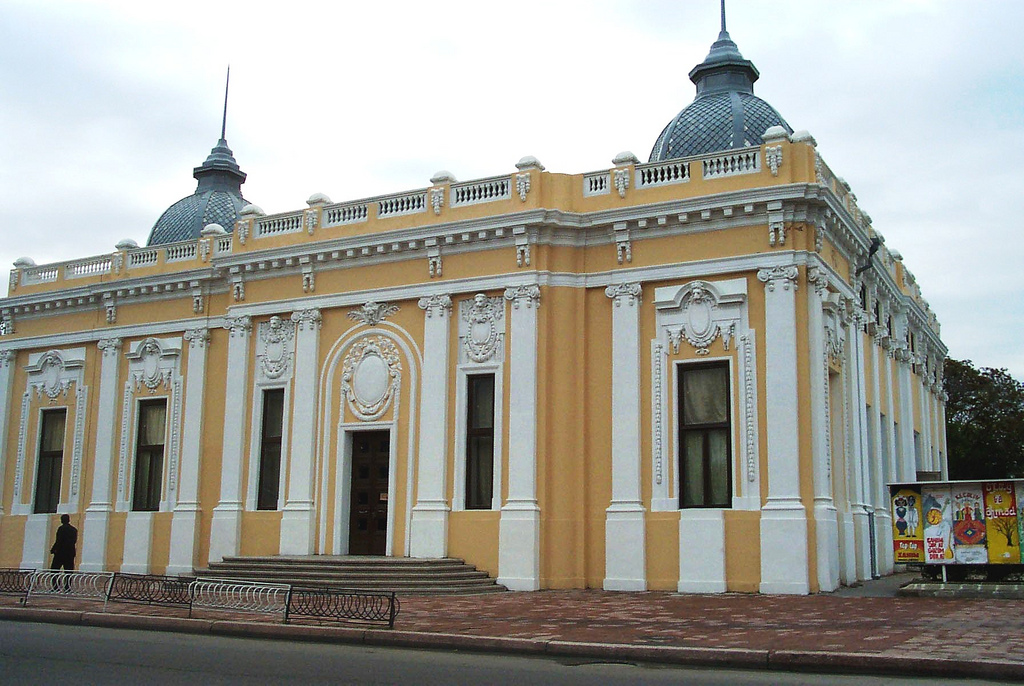 You'll emerge beside the dinky old Puppet Theatre (16) on the bulvar. Join the smoochy young lovers strolling the seafront promenade or the families enjoying funfair rides. Notice the open-sided Mirvari Kafesi (17; Pearl Cafe), whose scallop-shell concrete roof is as archetypally Soviet as the pinafored babushkas who serve here. Nearby is the departure pier for short pleasure-boat trips (18) into the bay, whose waters glint rainbow colours with the sheen of oil.
You'll emerge beside the dinky old Puppet Theatre (16) on the bulvar. Join the smoochy young lovers strolling the seafront promenade or the families enjoying funfair rides. Notice the open-sided Mirvari Kafesi (17; Pearl Cafe), whose scallop-shell concrete roof is as archetypally Soviet as the pinafored babushkas who serve here. Nearby is the departure pier for short pleasure-boat trips (18) into the bay, whose waters glint rainbow colours with the sheen of oil.
Cross back across Neftcilar pr to the colonnaded building that accommodated Carpet Museum (19) until recently, though this can be challenging due to the constant traffic.
Carpet and theatre museums
 The imposing, former Lenin Museum is a pseudo-Greek acropolis facing Baku's waterfront and built on the site of a 19th-century circus. While most of the space appears to be used as stairways and atrium, the building still finds room for three museums (and on paper, a fourth, the Museum of Religion, which has been on ice for years). By far the biggest attraction is the Carpet Museum. At any one time it displays around 1300 of the 6000 carpets of the permanent collection.
The imposing, former Lenin Museum is a pseudo-Greek acropolis facing Baku's waterfront and built on the site of a 19th-century circus. While most of the space appears to be used as stairways and atrium, the building still finds room for three museums (and on paper, a fourth, the Museum of Religion, which has been on ice for years). By far the biggest attraction is the Carpet Museum. At any one time it displays around 1300 of the 6000 carpets of the permanent collection.
Then stroll through Baku's commercial centre to Sahil Garden (20). The garden's focus was a memorial (21) to the 26 Commissars (though recently destroyed and replaced by some vulgar fountain), and there are several fine buildings nearby including the statue-encrusted national library, the Akhundov Kitabxana (22). Around the corner the classically styled Rashid Behbudov Song Theatre (23) was once Baku's main synagogue (two newer ones still operate).
The city's fine Opera House (24) welcomes you to Nizami kuc, Baku's most cosmopolitan pedestrianised shopping street, whose many fine century-old mansions will lead you back to Fountain Square via the Passaj Tourist Market (25) and the old Armenian Church (26).
A stroll along Nizami Street

At the Vurgun Str junction is a handy taxi rank beside one of the most impressive mid-20th-century buildings in the city. Across the road, the small park is surveyed by a graceful statue of Nasimi, the 15th-century poet, mystic and heretic who got himself skinned alive for being a little too progressive minded.
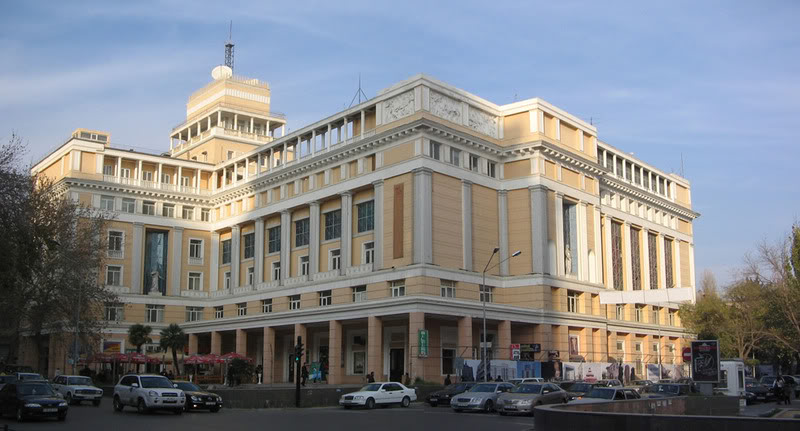 Nizami cinema and Niyazi Museum
Nizami cinema and Niyazi Museum
A couple of blocks north of Nizami St is the massive 1934 Nizami Cinema. Designed by Dadashev and Useynov (who also masterminded the Axundov Library and Nizami Museum refit) it has pink walls and stained-glass backed statuettes to temper its great Stalinist bulk.
The opera-ballet (24)
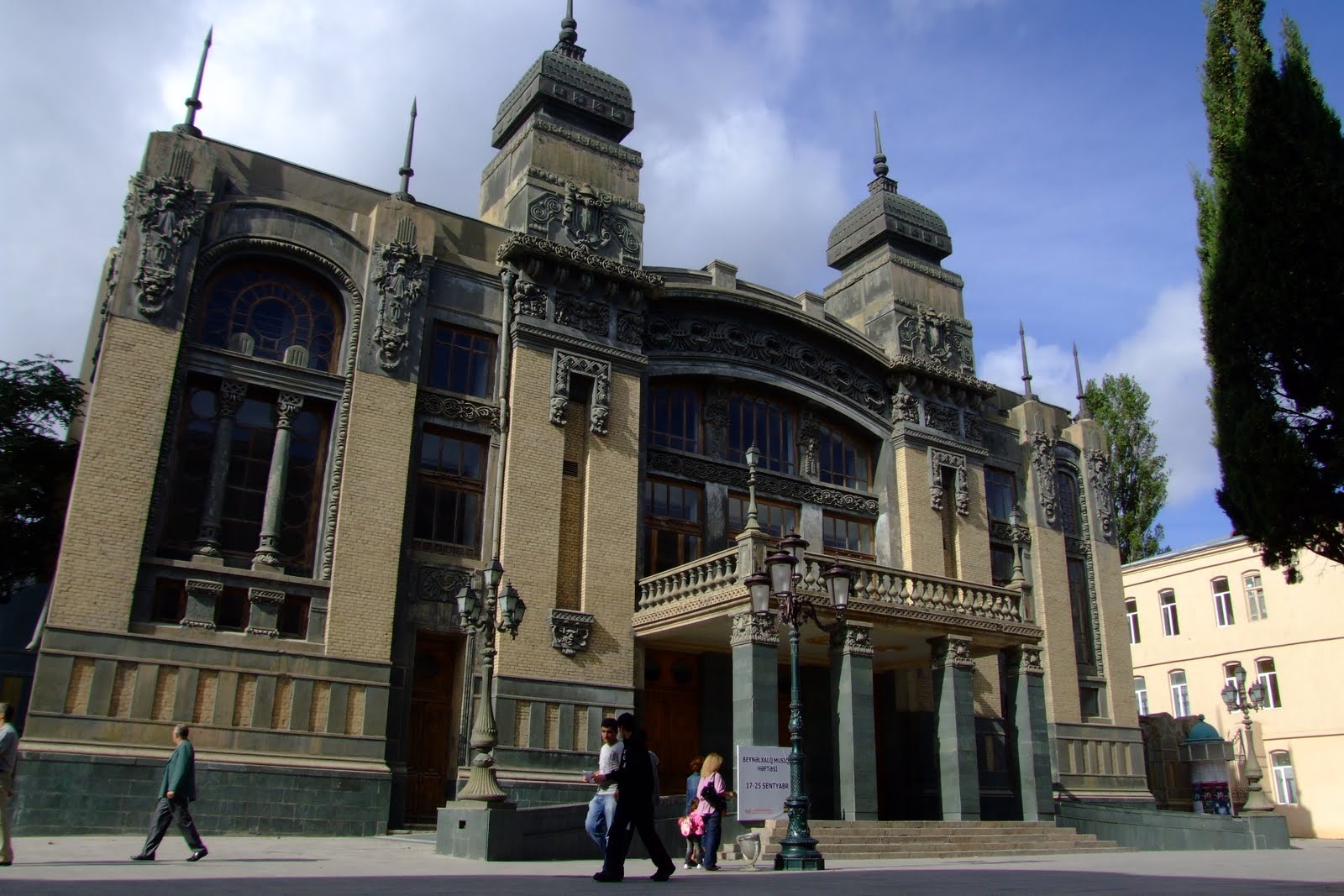
In 1909 the wealthy Manilov brothers set off to tour Europe. En route they were captivated by an Argentinean opera star and tried to persuade her to visit them in Baku. 'Is there somewhere for me to perform?' she demanded having little idea what sort of place Baku might be. There wasn't. But the brothers brushed over this detail and assured her that there would be by the time she arrived. The beautiful opera-ballet was thus planned, designed, and completed within a year. It still retains its original lavish gilded decor, torso columns, rounded proscenium and elegant galleries, though paint is peeling a little on some of the stairways. The 'ОТ' monogram on the exterior simply stands for Opera Theatre.
Tickets in the stalls for a full ballet/opera are sold from an office next door. Despite the low cost, shows are lavish and generally of a high standard. Even in lesser productions, the captivating sets make up for occasionally static performances. It is best to avoid the cheapest seats in the gallery where students insist on chatting throughout the performance. Shows generally start at 6pm on weekend evenings, October to May. For advertisements check the info here.
26 Commissars Square / now Axundov Square
 In the middle of the park, a block south of the Opera House, was a huge white figure appearing to have exhausted himself burrowing out of the ground and has earned himself a massive white-concrete halo. This statue and a eternal flame beside it used to honour the historically ambivalent 26 Commissars (see menu on the left). Now it is replaced by some vulgar fountain in the form of big martini glass.
In the middle of the park, a block south of the Opera House, was a huge white figure appearing to have exhausted himself burrowing out of the ground and has earned himself a massive white-concrete halo. This statue and a eternal flame beside it used to honour the historically ambivalent 26 Commissars (see menu on the left). Now it is replaced by some vulgar fountain in the form of big martini glass.
The square is host to the Axundov Library - the national book repository which is open to readers and researchers by request. Entrance is free but, just as at the British Library in London, the signing-in process can be somewhat laborious. The building's exterior is punctuated with statues in the style of the Nizami Museum but without the blue majolica-tiled mosaics.
If you're planning a trip to Baku you may need: 1) A wide selection of accommodation options in Baku (basic hostels, budget hotels for unpretencious travelers, small size family run hotels, international business hotel chains). 2) Practical information for tourists (visa regime, prices, best time to vizit and etc). Please do not hesitate to contact us for consultation



